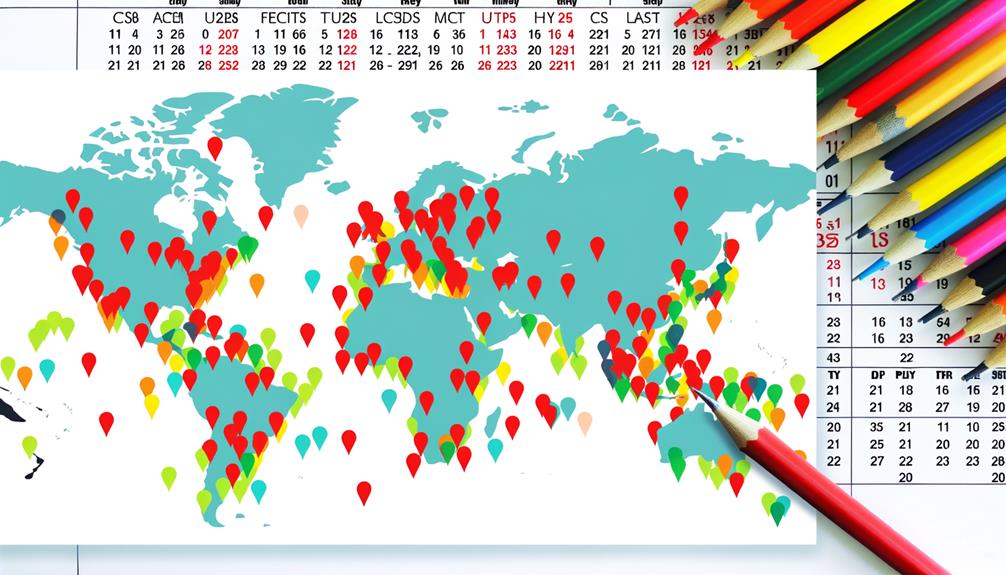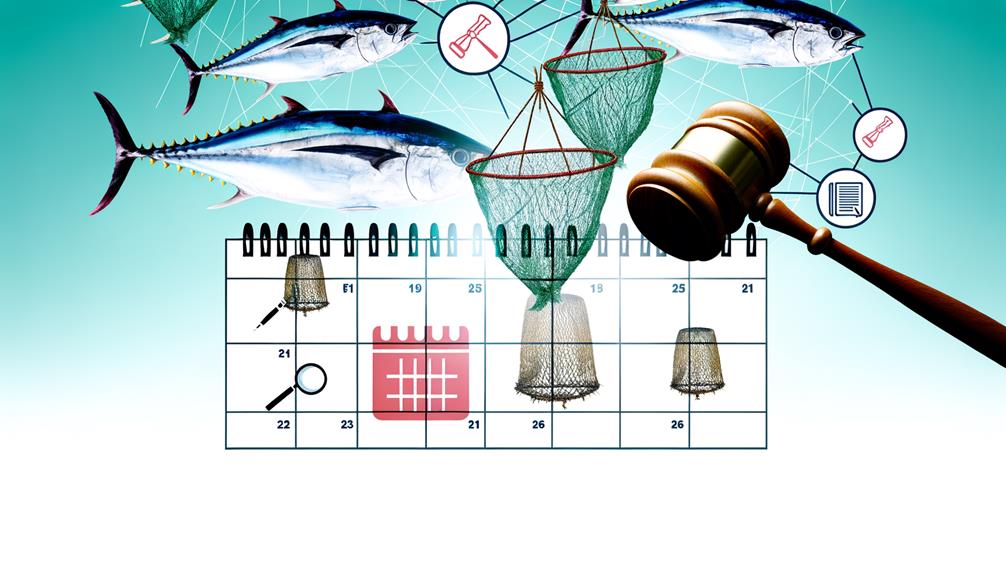While your granddaddy might have told you tales of year-round tuna fishing, today's reality is quite different. You see, the length of the tuna fishing season isn't as simple as dusting off your rod when the sun's high and the weather's warm. It varies widely depending on location, species, and local regulations.
It's a complex dance between man, fish, and nature. And understanding this dance, well, that's key to maximizing your catch. But what factors should you really be considering, and how do they all intertwine? That's a question worth exploring further.
Key Takeaways
- Tuna fishing seasons vary depending on factors such as migration patterns, spawning cycles, and ocean currents.
- Notable tuna fishing locations include Florida, California, Massachusetts, Louisiana, and New Jersey.
- Different tuna species have specific seasons, such as Atlantic bluefin tuna from June to November along the Eastern North American seaboard.
- Adhering to regulations set by the National Marine Fisheries Service is crucial for sustainable fishing practices and avoiding fines or penalties.
Understanding Tuna Fishing Seasons
While you might think that you can fish for tuna year-round, it's critical to understand that specific seasons, influenced by factors such as migration patterns and spawning cycles, significantly impact the availability and quality of your catch. The Tuna Fishing Season isn't just a date on a calendar; it's a dynamic period that involves understanding tuna fishing seasons and their intricate interplay with the life cycle of these magnificent creatures.
You see, tuna don't spawn all at once, but rather in waves throughout the year. This spawning cycle results in different stages of tuna availability during the fishing season, affecting the size, quality, and quantity of your catch.
Furthermore, migration patterns also play a critical role. Tuna are notorious for their long-distance migrations, often traveling thousands of miles. These movements are influenced by factors such as ocean currents, food availability, and temperature changes.
Factors Determining Tuna Seasons
Building on the complexity of tuna fishing seasons, it's vital to consider various factors that determine these seasons, ranging from location-specific weather patterns to species-specific characteristics. You'll find that location and weather patterns significantly impact the length of the season. Remember that different states have unique regulations and schedules, so familiarize yourself with these to plan your trips effectively.
The characteristics of the tuna species you're targeting also play a role. Tuna's warm-blooded nature allows them to be active even in lower temperatures, potentially extending the fishing season. Federal regulations, enforced by the National Marine Fisheries Service, certainly affect the timing of the season. It's important to adhere to these for sustainable fishing practices.
Species-specific factors are also key. Each species of tuna, be it bluefin or yellowfin, has unique traits, migrations, and fishing techniques. These factors significantly influence the timing and duration of their specific seasons.
Notable Tuna Fishing Locations

You'll find that tuna fishing seasons can differ greatly based on location, with places like Florida and Louisiana offering year-round tuna fishing opportunities, while states like Massachusetts, New Jersey, and California have specific seasonal windows. These notable tuna fishing locations each have their unique appeal and species to offer.
- Florida, often dubbed as the fishing capital, boasts a diverse range of tuna species. Here, you can indulge in:
- Yellowfin tuna fishing, promising an exhilarating experience.
- Blackfin and bluefin tuna fishing, offering a challenging yet rewarding adventure.
On the other hand, California's season typically starts in July and ends in September. It provides:
- Prime summer fishing conditions.
- A great opportunity to catch tuna during these balmy months.
Massachusetts presents a different scenario. Its tuna fishing season can range from early June through November, with the prime months being August and September. This is where you can partake in Atlantic bluefin tuna fishing off the east coast.
Each location presents a unique challenge and opportunity, making for an inclusive and engaging fishing experience. So, strap on your gear, join the community, and embark on your next fishing adventure today!
Variations in Tuna Species Seasons
You'll find that each tuna species has its own unique fishing season. These timelines are influenced by factors like migration patterns, which vary seasonally.
Understanding these variations can greatly enhance your success in tuna fishing.
Different Tuna Species Timelines
While there's a broad timeframe for tuna fishing, it's crucial to note that the exact season can vary significantly depending on the species of tuna and the location. For instance:
- Atlantic bluefin are typically caught from June to November along the Eastern North American seaboard.
- Pacific bluefin and yellowfin have slightly different tuna species timelines. They are:
- Caught off California's coast from May to October for Pacific bluefin.
- Yellowfin are primarily caught off Texas, Louisiana, Southern California, and Hawaii during summer or early fall.
Each species has its unique timeline. You, as part of our fishing community, should be aware of these variations. This understanding won't only enhance your sense of belonging but also increase your chances for a successful catch.
Seasonal Tuna Migration Patterns
Taking into account these differing timelines for catching various tuna species, it's key to delve deeper into why these variations occur, which brings us to the fascinating topic of seasonal tuna migration patterns.
Bluefin tuna season, for instance, differs for Atlantic and Pacific varieties due to their unique migratory paths. Atlantic bluefin are found off the Eastern North American seaboard from June to November, while Pacific bluefin are off California's coast between May and October. These periods are when they're most accessible to you, the angler.
Understanding these patterns allows you to plan your fishing trips effectively and responsibly. It's not just about when you can fish, but also where and why.
Join the community of informed fishermen who respect the oceans and their inhabitants.
Impact of Regulations on Tuna Fishing

Navigating the complex web of federal regulations set by the National Marine Fisheries Service is critical for those seeking to responsibly fish for bluefin and yellowfin tuna, even in state waters. This understanding of the impact of regulations on tuna fishing in the United States, and adherence to them, is the first step towards sustainable fishing practices.
Violating these regulations can inflict fines and penalties, which can be detrimental to your fishing ventures. Knowing the fishing seasons and locations for different species like Atlantic bluefin, Pacific bluefin, and yellowfin tuna is essential.
- Be aware that
- Different species have distinct fishing seasons
- Locations affect the type of tuna you can fish
Keeping updated with regulation changes ensures a successful and hassle-free fishing trip. This isn't merely about catching fish, but about belonging to a community that values and respects the marine ecosystem.
Maximizing Your Tuna Fishing Success
To maximize your success in tuna fishing, it's crucial to grasp the behavior of the different tuna species.
Equipping yourself with the ideal fishing gear is equally important, as it enhances your chances of a successful catch.
Lastly, understanding the seasonal migration patterns of tuna can help you be in the right place at the right time, further boosting your success rate.
Understanding Tuna Behavior
Diving into the realm of tuna behavior, you'll find that each species boasts unique characteristics and requires different fishing techniques, making it imperative to understand these nuances for successful tuna fishing.
- Understanding Tuna Behavior
- *Tuna species*: Each species of tuna possesses its own unique characteristics. Recognizing these differences allows you to adapt your techniques accordingly.
- *Fishing Techniques*: Tuna fishing isn't a one-size-fits-all endeavor. Your success hinges on your ability to adjust your methods based on the species you're targeting.
Ideal Tuna Fishing Gear
Having grasped the nuances of tuna behavior and the different fishing techniques, it's crucial you equip yourself with the ideal tuna fishing gear to maximize your success in tuna fishing.
A 50 to 80-pound class conventional reel and heavy rod is recommended. This gear, robust and efficient, can handle the strength and speed of tuna.
Knowledge about regional regulations, set by the National Marine Fisheries Service, is also vital. Don't overlook the importance of proper research and preparation. Your ideal gear isn't complete without a well-thought-out plan, so stay updated with the latest rules.
What you need to know is that the right tackle and readiness can make a significant difference in your tuna fishing success.
Seasonal Tuna Migration Patterns
Understanding the seasonal migration patterns of different tuna species like Atlantic bluefin, Pacific bluefin, and yellowfin can significantly boost your success in tuna fishing, as these patterns determine the best fishing seasons across various US coastal regions. You're not just fishing; you're part of a community committed to sustainable practices and respect for these magnificent creatures.
- Atlantic bluefin
- Known for their winter migration along the Atlantic coast.
- Fishing season peaks around late fall.
- Pacific bluefin and yellowfin
- Migrate to the Pacific coast during summer.
- Optimal fishing season starts late spring.
Frequently Asked Questions
How Long Is the Fishing Season on Wicked Tuna?
The fishing season on Wicked Tuna varies, but it generally aligns with the Atlantic bluefin tuna season, starting in June and ending in November. It's influenced by the show's impact and crew selection process.
How Much Does a Tuna Fisherman Make a Year?
As a tuna fisherman, you're riding the waves of tuna market dynamics. Your earnings, between $30,000 and $100,000 annually, hinge on the species caught, fishing area, catch quantity, and adapting to fluctuating market conditions.
How Long Is Outer Banks Tuna Fishing Season?
In the Outer Banks ecosystem, tuna fishing season varies. However, it typically runs from May to October. It's crucial you're aware of tuna conservation methods to promote sustainable fishing in these rich waters.
What Month Is Best for Tuna Fishing?
Ironically, you're asking about the best month for tuna fishing, not considering tuna breeding patterns. Generally, summer's ideal, but it varies by region and preferred tuna bait. Analyze local patterns for the best results.
Conclusion
So, you've got the lowdown on tuna fishing seasons. Remember, it's not just about casting a line; it's about understanding the rhythms of nature and respecting her rules.
While each species has its own dance card, regulations also play a big part in the game. And let's not forget location, that's key too.
So, with the right knowledge and respect for the process, you're all set to make the most of your tuna fishing adventure.
